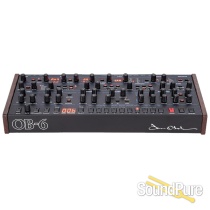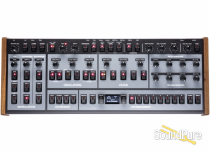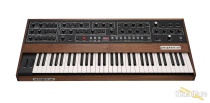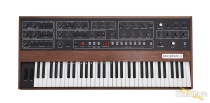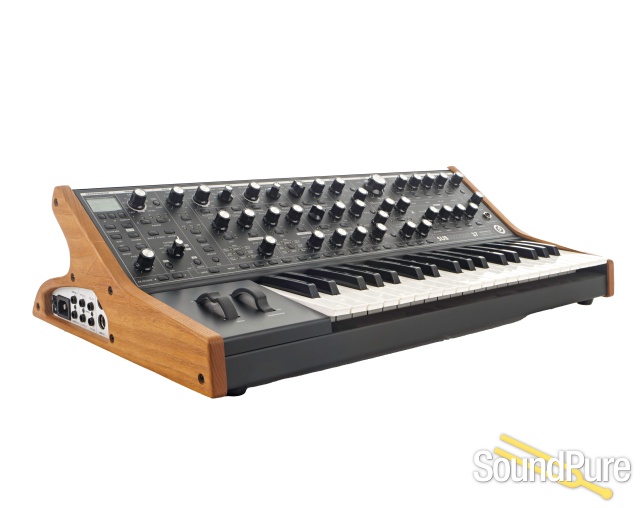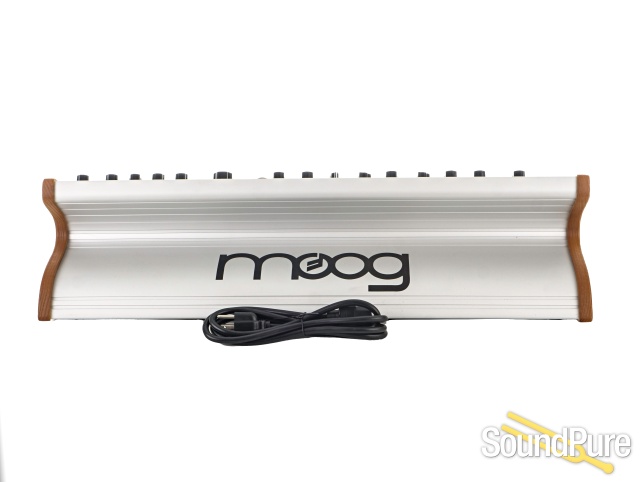SOUND ENGINE: 100% Analog
POLYPHONY: Selectable Monophonic or Paraphonic
KEYBED: 37 Note Semi-weighted with After Pressure
LCD: 128 X 64 pixel LCD with white backlight
CONTROLLERS: Pitch Bend, Mod Wheel, After Pressure, Velocity
SOUND SOURCES: 2 Variable Waveshape Oscillators, 1 Square Wave Sub Oscillator, 1 Analog Noise Generator, 1 External Input/Filter Feedback
OSCILLATOR CALIBRATION RANGE: 22Hz-6.8KHz. Note range at 8’ = 18 - 116
GLIDE MODULE: Assign to Osc1/Osc2/Both. Type - LCR, LCT, EXP, Gated, Legato
FILTER: 20Hz-20KHz Moog Ladder Filter w/ 6/12/18/24 dB/Oct Filter Slopes and MultiDrive
TRANSPOSITION: +/- 2 Octaves
ARPEGGIATOR/SEQUENCER: Up, Down, Order, Random, Latching, Back/Forth, Invert, +/-2 Range, Tie, Rest, MIDI Sync, 64-note sequencer
LFO PANEL FEATURES: Hi/Low Range from .01Hz–1kHz, MIDI Sync, KB Reset
ENVELOPES: DAHDSR Envelopes with Multi-Trigger, Reset, Looping, MIDI Sync, Latch, and Variable control of EG Delay, Hold, Velocity Amount, KB Tracking.
PRESETS: 256 Presets - 16 Banks x 16 presets
MODULATION BUSSES
SOURCES: LFO (Triange, Square, Saw, Ramp, Sample & Hold), Filter EG/PGM
PROGRAMMABLE SOURCES:
- Amp Env
- Constant ON
- Sine LFO
- Noise LFO
- Osc 1 Pitch
- Osc 2 Pitch
- Seq Note
- Seq Vel
- Seq Mod
DESTINATIONS:
- Osc 1 & 2 Pitch (separate or both)
- Filter
- LFO Rate
- VCA Level
- Osc 1 & 2 Wave (separate or both)
- Noise Level
- EG Time/PGM
PROGRAMMABLE DESTINATIONS:
- Filter Resonance
- Filter Drive
- Filter Slope
- Filter Env Amount
- Filter Keyboard Amount
- Osc 1 Level
- Sub Osc Level
- Osc 2 Level
- External In/Feedback Level
- Osc 1 On
- Sub Osc On
- Osc 2 On
- Noise On
- External In/Feedback On
- Arp Rate
- Arp Clock Division
- Arp Range
- Arp Back/Forth
- Arp Ends
- Arp Invert
- Arp Gate Length
- Arp Run
- Glide Time
- Glide OSC Choice
- Glide Type
- Glide Gate
- Glide Legato
- Glide On
- LFO 1 Clock Division
- LFO 1 Range
- LFO 1 Sync
- LFO 1 Keyboard Reset
- LFO 1 Keyboard Track
- Mod 1 Pitch Amount
- Mod 1 Filter Amount
- Mod 1 Programmable Amount
- Mod 1 Programmable Destination
- LFO 2 Clock Division
- LFO 2 Range
- LFO 2 Sync
- LFO 2 Keyboard Reset
- LFO 2 Keyboard Track
- Mod 2 Pitch Amount
- Mod 2 Filter Amount
- Mod 2 Programmable Amount
- Mod 2 Programmable Destination
- Osc 1 Oct
- Osc 2 Sync
- Osc 2 Keyboard Reset
- Osc 2 Oct
- Osc 2 Keyboard Control
- Osc 2 DUO Mode
- Osc 2 Freq
- Osc 2 Beat Freq
- Filter Env Attack
- Filter Env Decay
- Filter Env Sus
- Filter Env Release
- Filter Env Delay
- Filter Env Hold
- Filter Env Vel Amount
- Filter Keyboard Track
- Filter Env Multitriggering
- Filter Env Reset
- Filter Env Sync
- Filter Env Loop
- Filter Env Latch
- Amp Env Attack
- Amp Env Decay
- Amp Env Sus
- Amp Env Release
- Amp Env Delay
- Amp Env Hold
- Amp Env Vel Amount
- Amp Keyboard Track
- Amp Env Multitriggering
- Amp Env Reset
- Amp Env Sync
- Amp Env Loop
- Amp Env Latch
- Output Volume
- Bend Up
- Bend Down
I/0
AUDIO INPUT: 1xTS
AUDIO OUTPUT: 1xTS, 1xTRS Headphone with separate volume control
MIDI I/O: DIN In/Out, and MIDI over USB
CV/GATE INPUTS: Filter CV, Pitch CV, Volume CV, KB Gate
POWER: 110VAC-240VAC Universal Power Supply with IEC connector
WEIGHT: 22lbs
DIMENSIONS: 6.75"H x 26.75”W x 14.75”D








